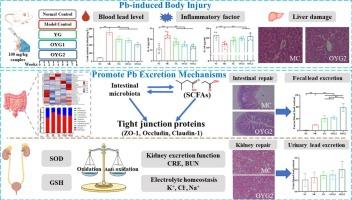Oxidized yeast glucan alleviates lead-induced toxicity in mice by improving intestinal health to inhibit Pb absorption and reducing kidney oxidative stress
Author links open overlay panelShuai Chen, Xinyi Zhu, Yujie Guo, Ningzhe Kang, Qilin Huang
https://doi.org/10.1016/j.ijbiomac.2024.139205Get rights and content
Highlights
- OYG usefully reduces blood lead with highly oxidized OYG2 being the highest efficacy.
- OYG protects Pb-exposed mice by inhibiting inflammation and repairing liver damage.
- OYG relieves oxidative damage and restore kidney function, facilitating Pb excretion.
- OYG repairs intestinal barrier by regulating gut microbiome and SCFAs.
- OYG restores intestinal function and reduce Pb absorption, facilitating Pb excretion.
Abstract
This study investigated the protective effects and Pb-excretion mechanisms of yeast glucans (YG) with varying oxidation degrees in Pb-exposed mice. Results demonstrated that all three glucans effectively reduced blood lead levels, alleviated inflammation, and mitigated liver damage in Pb-exposed mice, with highly oxidized yeast glucan (OYG2) exhibiting the greatest efficacy. Furthermore, the glucans attenuated Pb-induced oxidative stress and pathological changes in the kidney by elevating glutathione and superoxide dismutase levels, thereby restoring renal excretory function (blood urea nitrogen and creatinine). This restoration contributed to maintaining electrolyte homeostasis (Na+, Cl−, K+) and significantly enhanced lead excretion efficiency via urine. Additionally, the glucans modulated intestinal microbiota balance, promoted short-chain fatty acid production, and repaired Pb-induced intestinal barrier damage by upregulating tight junction proteins (ZO-1, Occludin, Claudin-1). In conclusion, yeast glucans, particularly OYG2, effectively inhibited Pb absorption and facilitated its excretion through feces, highlighting their potential as a therapeutic strategy for lead toxicity.
https://www.sciencedirect.com/science/article/abs/pii/S0141813024100165


Comments